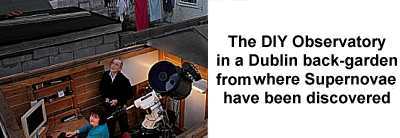| HELP TO KEEP THIS NEWSLETTER ALIVE! | ||
|
NEED A MOTHER'S DAY, WEDDING, ANNIVERSARY OR BIRTHDAY GIFT? Shop Online at https://www.irishnation.com |
||

Stunning Irish Jewelry |

Gorgeous Galway Crystal |

'Woman in Charge' Sign |

Marvellous Family Crest Shields |
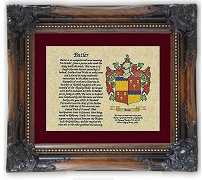
Framed Family Crest |

Display your Heritage: Family Crest Flags |
| More Gift Ideas From Ireland | ||
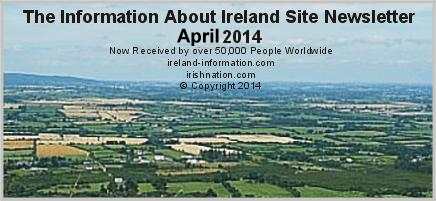
============
IN THIS ISSUE
============
=== News Snaps from Ireland
=== The GPO, Dublin
=== The National Wax Museum, Dublin
=== Hillside by Jeremiah J. Shea
=== The Irish of Argentina by Santiago Boland
=== Gaelic Phrases of the Month
=== Monthly Free Competition Result
Popular Articles from Recent Newsletters:
The Monster of Lough Ree by Pat Watson
Leinster House, Dublin
Dublinia
==========
FOREWORD
==========
|
Ireland seems to be on the cusp of a recovery. The Construction Cranes are starting to appear above the Dublin skyline again as pent-up demand for building work is finally released while politicians pat themselves on the back claiming that the worst is over.
A weary populace are taking the self-congratulations with a pinch of salt however. It would not take much to plunge the country back to the depths of a recession. Nevertheless there are encouraging signs with unemployment reducing (aided by emigration) and property prices increasing (aided by lack of supply in certain areas). Grounds for optimism certainly but no need to resurrect the Celtic Tiger just yet. Until next time, Michael |

PLEASE 'LIKE US' ON FACEBOOK!
P.S. Please DO FORWARD this Newsletter to a
friend or relative. If you have a website or Facebook
page or Blog (or whatever!) then you can help
us out by putting a link on it to our website:
www.ireland-information.com
Do tell your friends about us as this helps
to keep this newsletter free!
==========================
NEWS SNAPS FROM IRELAND
==========================
|
KEEP THIS NEWSLETTER ALIVE! Free Mount with ALL Family Crest Prints, Framed or Unframed 
Order from Here |
Find Your Name in our Gallery of Irish Coats of Arms:
| A | B | C | D | E | F |
| G | H | I | J | K | L |
| M | N | O | P | Q | R |
| S | T | U | V | W | Y |
THE PERFECT WEDDING, ANNIVERSARY OR BIRTHDAY GIFT!
We now have over 100,000 worldwide names available.
Get the Coat of Arms Print, Claddagh Ring,
Screensaver, Plaque, Tee-Shirt or Clock for
your name at:
https://www.irishnation.com/familycrestgifts.htm
==============================================
IRELAND'S MOST POPULAR TOURIST ATTRACTIONS
==============================================
|
FREE ATTRACTION #18: THE GENERAL POST OFFICE (GPO), DUBLIN
The GPO in Dublin is located on O'Connell street and is a matter of a few hundred yards from Trinity College, Grafton Street, Dublin Castle, Christ Church Cathedral and the National Gallery of Ireland. 
The GPO is the oldest working Post office in the world and is an impressive Georgian building that dates from 1818. It is most associated with the Easter Rising of 1916. It is on the footsteps of the GPO that Padraig Pearse read aloud the ' Proclamation of the Irish Republic' to a startled Dublin citizenry. The week-long battle that followed all but destroyed not just the GPO but the inner city of Dublin itself. The Georgian facade of the GPO remained intact however and a new building was built around the old shell. An original copy of the 'Proclamation of the Irish Republic' is on permanent display inside the GPO where a small Museum is free to visit and educates all about the history of the building not just as a rebel stronghold but also as a fully functioning post office. A famous statue of Cúchulainn is housed in the main foyer while the GPO is also the home to the Irish Philately community, so if stamp collecting is your passion then be sure to visit the separate side-room where stamp exhibits and 'first day covers' can be viewed and bought. Indeed, sending a few postcards from the GPO has become something of a tradition for visitors to Ireland. The GPO can be very crowded at times so you may want to visit early in the morning to have a good look around. A visit to the Museum, a few photos, perhaps sending a few cards or buying a gift or two, should not take too long, maybe an hour or even less. But this is more than just another Museum-like artifact of Irish history to mark off your check-list. Although not in a geographic sense but perhaps in a psychological sense the GPO is the very centre of Ireland. It is from this space that a new nation at last began to emerge. 
For many people the Ireland of their imagination is rolling hills, sheep blocking main street traffic, picture-postcard imagery of Sean Thornton hurtling across a field with Mary-Kate in his wake. But for those who love history the GPO is the place in Ireland where reverence is appropriate. It is akin to walking across the field at Gettysburg where Pickett's Charge marked the beginning of the end of the Southern Confederacy and from where the United States would never be the same. It is like visiting the Place de la Bastille in Paris, from where the French Revolution fermented and France would be forever changed. The GPO represents the very heart and soul of the Irish nationalist movement. To the Irish the GPO in Dublin is a lot more than just a building. Find out more here: http://www.anpost.ie/AnPost/History+and+Heritage/Home/ FEE-PAYING ATTRACTION #18: THE NATIONAL WAX MUSEUM, DUBLIN The Wax Museum in the heart of Dublin city centre is a small modern Museum that will take visitors on a tour of the Irish past and has tributes to Irish scientific inventors and a kids 'discovery zone'. Vikings, scientists, writers, musicians as well as all the famous characters from Irish history jostle for attention in the newly renovated building that boasts a video room where visitors can even make their own music video set against a variety of backgrounds! 
Of course the great attraction for youngsters in a place like this is the Chamber of Horrors. Located in the basement the 'brave at heart' can meet Doctor Hannibal Lector, Dracula and the Wolfman. Be careful though as some of the wax figures are quite graphic and might upset the very young. Elsewhere in the four-storey building younger kids can meet replicas of Spongebob and Harry Potter. This is one of those attractions for the kids! The Museum is located just a few yards from Trinity College so could hardly be better located. If your tribe have had enough of being dragged around Dublin and are due a bit of fun and a treat then do consider the Wax Museum. A couple of hours should do it. A Latte for you in the Cafe, ice cream for the gang. Everyone is happy. Find out more here: http://www.waxmuseum.ie |
KEEP THIS NEWSLETTER ALIVE!
Solve your gift problem at: https://www.irishnation.com

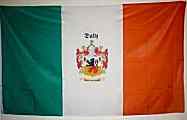
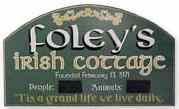
===========================
HILLSIDE
By Jeremiah J. Shea (1903-1964)
===========================
|
There's a hillside back in Erin, Stretching high above the bay, Where the sunset turns the heather Into gold at close of day. Peace is there when twilight lingers And the valley down below Seems a far off faerie playland With the cottage lamps aglow. Comes the moon through heaven's curtain Sailing high and clear and bright, With a host of stars aglitter, Bringing beauty to the night. 
And the ancient ivied castle Seems as full of life as yore With the moon exchanging shadows For her partners on the floor. There the cares of life are little On the hillside o'er the bay, There the soul of man is grateful, At the closing of a day. For the peace that comes too seldom It is there that I would be, And if I should fly tomorrow I would take you all with me! Jeremiah J. Shea |
KEEP THIS NEWSLETTER ALIVE!

Get Your Family Crest Flag at:
https://www.irishnation.com/familycrestflags.htm
|
======================= THE IRISH OF ARGENTINA by Santiago Boland ======================= The Southern Cross Newspaper of Argentina published the following on 16th January, 1875: 'In no other region of the world is the Irishman more respected and esteemed than in the Province of Buenos Aires. And in no other part of this planet have the Irish immigrants prospered with such good fortune...' 
Don Pedro de Mendoza's fleet arrived at e Rio de la Plata in 1535, and founded the city of Buenos Aires. Mendoza was the Spanish conquistador, soldier and explorer. Among his crew members were two men of Irish descent, they being Juan and Tomas Farrell. Three years later other Irishman arrived including Juan Gordon, along with Royal Inspector Cabrera. When Buenos Aires was utterly destroyed, they moved to Asuncion, and a few years later their descendants, Rafael Farrell and Diego Gordon, participated in the foundation of Corrientes by Don Juan Torres de Vera y Aragon. It was not surprising that many Irishmen would serve the Catholic royalty after fleeing to Spain or its colonies. When Henry VIII separated the Church of England from the Roman Catholic Church a religious persecution began in Ireland, which had remained faithful to Rome. These persecutions were much worse under Elizabeth I, his daughter, and her agent Cromwell took them to the extreme. Among the first Irish to settle in the Rio de la Plata were Fathers Thomas Field, from Limerick, and Thomas Falkner, a son of an Irishman. They were followed by some who kept their original family name - such as the names Lynch and O'Gorman - while others adopted a Spanish version of their names, as was the case of Kennefick, who changed it into Reinafe. Though an irony of fate, the coming into existence of the Irish-Argentine community begun with the British Invasions. In 1806 a fleet, under the command of Commodore Popham, came to shore at Quilmes and marched into the city of Buenos Aires. A General Beresford was in charge of the fleet and infantry. The city was taken without any resistance, as there were no proper defenses or forces available. During the occupation, many of the Irish soldiers, forced to fight for the English, felt a much deeper bond with the local population than with the invading forces and therefore decided to switch sides and fight alongside the improvised domestic troops! Beresford found himself obliged to threaten with martial law measures for any person encouraging his soldiers to desert. One, by the name of Skennon, who joined Pueyrredon' s army in Perdriel, did not cease to fire his cannon until the moment he was captured and taken prisoner. His fate was sealed: he was publicly executed in the Plaza de Mayo, after receiving the holy sacraments from the Bishop of Buenos Aires. On August 12th, Beresford surrendered to Santiago de Liniers and the defeated soldiers, many Irishmen among them, were sent inland to different cities. In July, 1807, twelve thousand men, under the command of John Whitelocke, tried once again to take possession of Buenos Aires. But this time the local forces massacred them with hot oil strewn from the roofs. this time they were ready! The Basilica of the Virgin of the Rosary still treasures the captured British flags that were offered as a sign of surrender. The capitulation established a definite withdrawal date for the British military and an exchange of prisoners, since many refused to rejoin the English army, because they had already decided to settle in the country. They swore allegiance to the King of Spain, and raised their families and even adopted Spanish surnames such as Perez, Garcia, Mendoza or Sanchez. These Irish soldiers may very well have been in the British battalion that were part of the Army that crossed the Andes. It is from these beginnings that a small Irish community was formed, and it grew in size with the addition of other immigrants who arrived in Argentina for trading purposes or who landed here by mere chance as was the case of Brown himself. Catholic Priests were needed. The language differences and the special functions of priests in Irish society, were the basis of a request for priests to be sent from Ireland. Burke (a Dominican), Father Moran, who passed away a year after his arrival, and Father Patricio O'Gorman, from 1831, were successively the Irish chaplains in Buenos Aires. Father Antonio Fahy arrived in 1844 to help Father O'Gorman in his task. The existence of the small Irish community, the tragic situation of Ireland during those days (famine and extreme poverty), the expansion of sheep rearing under General Rosas and the unwavering work of Father Fahy were the main factors behind an increase in the number of people arriving from Ireland in Argentina until about the year 1860. Aware of the possibilities offered by the Province of Buenos Aires and mostly having their passage paid by a countryman who had arrived before, they were received by the local Irish and then went to work in the rural areas, where they were periodically visited by the Chaplain. This country was a very alluring perspective for our ancestors, and thus here we are today. 
This Irish community in Argentina is the largest in any non-English speaking country in the world and is the fifth largest in the world. We still try to keep up the inherited traditions and to rescue those other traditions that have been lost over time. It is estimated that there are between a half and one million Irish descendants in modern-day Argentina. Santiago Boland / Bahia Blanca |
================================
GAELIC PHRASES OF THE MONTH
================================
| PHRASE: | Faigh do chóta agus cuir ort é |
| PRONOUNCED: | fye-igh duh koh-ta oggus qwir urt a (a as in A,B,C) |
| MEANING: | Get your coat and put it on |
| PHRASE: | Tá sé fuar go leor inniu |
| PRONOUNCED: | taw shay foor guh lore inn-u |
| MEANING: | It is cold today |
| PHRASE: | Déan deifir! |
| PRONOUNCED: | dane deffer |
| MEANING: | Hurry Up! |
View the archive of phrases here:
https://www.ireland-information.com/irishphrases.htm
KEEP THIS NEWSLETTER ALIVE!
Get Great Family Crest Gifts at:
===================
COMPETITION RESULT
===================
The winner was: chris@chicagovps.net
who will receive the following:
A Single Family Crest Print
(US$19.99 value)

Send us an email to claim your print, and well done!
Remember that all subscribers to this
newsletter are automatically entered into the
competition every time.
I hope that you have enjoyed this issue.

by Michael Green,
Editor,
The Information about Ireland Site.
https://www.ireland-information.com
Click here to contact us
Google+
PLEASE 'LIKE US' ON FACEBOOK!
KEEP THIS NEWSLETTER ALIVE! Visit https://www.irishnation.com
(C) Copyright - The Information about Ireland Site, 2014
P.O. Box 9142, Blackrock, County Dublin, Ireland Tel: 353 1 2893860
